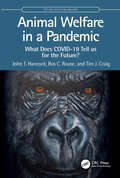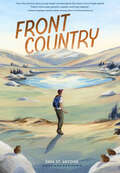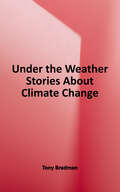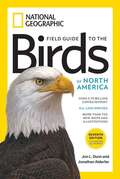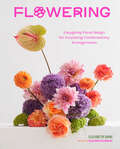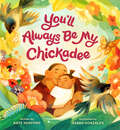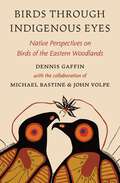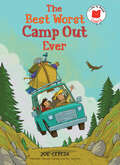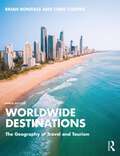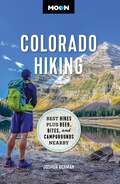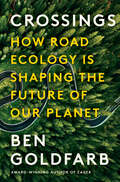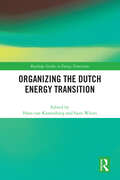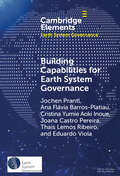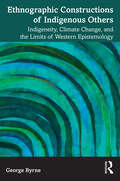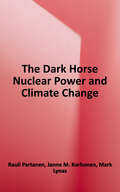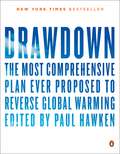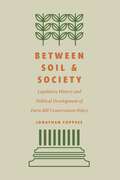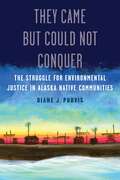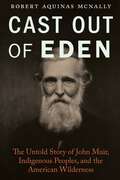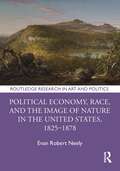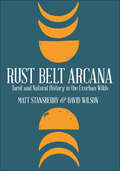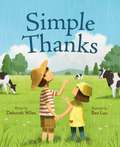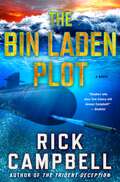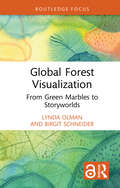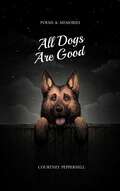- Table View
- List View
Animal Welfare in a Pandemic: What Does COVID-19 Tell us for the Future? (CRC One Health One Welfare)
by John T. Hancock Ros C. Rouse Tim J. CraigAnimal Welfare in a Pandemic explores the impact of COVID-19 on a wide array of animals, from those in the wild to companion and captive animals. During the height of the pandemic, a range of animals were infected, and many died, but this was hard to predict, even using up-to-date bioinformatics. Lockdowns around the world had, and continue to have, a major effect on animals’ welfare, influencing pet ownership and care, as well as impacting on the work of conservation institutes due to the lack of visitors and funding and lack of tourist presence in the wild which impacted on anti-poaching efforts. Some of the vast amount of personal protection equipment (PPE) that was distributed was discarded, creating both dangers and occasional opportunities for wild animals. With the rollout of human vaccines, some countries started developing animal vaccines, only some of which were deployed. In summary, the pandemic had a wide-ranging influence on animal welfare around the world. This is reviewed to highlight what can be learned to protect and enhance animal welfare in future epidemics/pandemics, and contribute to a genuinely One Health approach where the health and welfare of both humans and animals are considered holistically.This book is authored by members of the University of the West of England, Bristol, who span a range of expertise in Biological Sciences, Social Sciences, Animal Welfare, and Ethics.
Front Country
by Sara St. Antoine"This is a story about the ache and promise of our world, and it begs us to pay attention to both. A terrific and important read."―Gary D. Schmidt, Newbery Honoree, Printz Honoree, and National Book Award Finalist for Okay for Now "Give this novel to every young reader worried about the future of our fragile planet."―Katherine Applegate, Newbery Medal–winning and #1 New York Times bestselling author of The One and Only Ivan My Side of the Mountain meets Greta Thunberg in this heartfelt, exciting novel about one girl’s growing awareness of herself, the world, and the relationship between the two. The world is not okay. Now what?Ginny Shepard is glad to be in Montana for a month of backcountry camping before she starts high school. The world is on fire. That's the awful truth. And Ginny would much rather be hiking in the mountains than doing the summer college prep classes her parents think will help her future. Because, the future? Who even knows what that is anymore.But once Ginny gets to camp, things get complicated fast. She meets her tripmates: five challenging, rebellious, tech-addicted boys. And she finds out TrackFinders is designed for kids who need extra "support." Instead of feeling free as a bird, Ginny feels trapped . . . and betrayed.As her friendships with her fellow campers deepen on the trail, though, Ginny starts to see new sides of them—and of herself. Maybe out here in the backcountry she'll actually find what she needs to face the front country again.Set in Montana's sweeping alpine wilderness, this epic adventure captures the tremendous heartbreak of realizing the world isn't okay at all and shows how that knowledge, and what we choose to do with it, shapes us into who we are. AN EMPOWERING ADVENTURE STORY: Despite humans' ever-worsening impact on the environment, there are relatively few books about the topic—especially for young readers, and especially that don't feel preachy. This book is an empowering adventure story, and it's also positive, not depressing.STRONG FEMALE PROTAGONIST: Ginny positively models dealing with strengths and weaknesses to readers, who are full of flaws but full of strengths, too. The way she struggles with both will speak to young readers. Even kids who are not interested in climate change will recognize her as a fellow young person and quickly become aware of the ways she's able to effect change—and the ways she still can't.STEM TOPICS: Educators and librarians will love tying this fictional story to nonfiction curriculum, and there are several different access points for this book from a scientific perspective. Environmental science, earth science, climate change, differing regional biomes, geology, and biology are all explored in real-world, character-driven ways.GIRLS IN SCIENCE: Ginny's passion for science shows readers that science-loving girls can be cool—and there are many different ways characters of all genders embrace science.A THRILLING PAGE-TURNER: In the tradition of Hatchet and Wolf Hollow, this book is an excellent, fast-paced story that's impossible to put down. Kids will love every character—or love to hate them—and will finish the book feeling like they're leaving friends behind. Perfect for:Animal loversKids who love adventure and natureTeachers and librarians
Under the Weather: Stories about Climate Change
by Tony BradmanFrom the effects of rising sea levels to changes in animal behaviour and human lifestyles, these powerful stories portray the issues surrounding climate change in personal terms and so bring them vividly to life. Offering warnings and inspiration in equal measure, the stories cover a wide range of localities from Siberia and Canada to Australia, UK, Sri Lanka, and the Philippines. Writers include award-winning Linda Newbery as well as exciting newcomers like Australia's George Ivanoff. Whether read from cover to cover or dipped into for one or two stories, this book will enlighten and inspire everyone to consider how climate change will affect us all.
National Geographic Field Guide To The Birds Of North America, 7th Edition
by Jonathan AlderferThis fully revised edition of the best-selling North American bird field guide is the most up-to-date guide on the market. Perfect for beginning to advanced birders, it is the only book organized to match the latest American Ornithological Society taxonomy. With more than 2.75 million copies in print, this perennial bestseller is the most frequently updated of all North American bird field guides. Filled with hand-painted illustrations from top nature artists (including the ever-popular hummingbird), this latest edition is poised to become an instant must-have for every serious birder in the United States and Canada. The 7th edition includes 37 new species for a total of 1,023 species; 16 new pages allow for 250 fresh illustrations; 80 new maps; and 350 map revisions. With taxonomy revised to reflect the radical new American Ornithological Society taxonomy established in 2016, the addition of standardized banding codes, and text completely vetted by birding experts, this new edition will top of the list of birding field guides for years to come.
Flowering: Easygoing Floral Design for Surprising Contemporary Arrangements
by Elizabeth JaimeA fresh, contemporary flower-arranging book from the Miami-based studio Calma Floral, with foundational tips, flower recipes, and bountiful photography that will teach you how to create irreverent arrangements for any occasion.Heralding a new era in floral design—one that favors a playful, modern aesthetic and a laidback approach—this guide to creating trend-forward flower arrangements invites you to think outside the box. Learn how to arrange unique, eye-catching bouquets by pairing unexpected combinations and incorporating a variety of elements and textures, such as fresh and dried blooms, rhinestones, fruit, and tropical foliage.Foundational tips for "flowering" set you up for success, and twenty step-by-step recipes (paired with step-by-step photos!) make it easy to design joy-filled floral moments—from a whimsical fountain of troll grass to a mossy mounded centerpiece, a Rococo-inspired piece worthy of Versailles, a suspended cloud of fluffy mimosa, and so much more. A must-have for hobbyists and experienced florists looking for something fresh, Flowering is the essential floral book for today.ONE-OF-A-KIND PIECES: With categories that include 360 Arrangements, Bud Vases + Tiny Arrangements, Party Time Flowers, Installations + Home Decor, and more, this book offers a wide range of flower design ideas. You'll find a piece for every occasion, whether you're looking for a bright bouquet of reflexed roses to gift to a friend, a table runner of carnations and candles for a dinner party, or an installation of dried palms to hang in your entryway.ALL-LEVEL DESIGNS: Flowering is perfect for weekend dabblers and professionals alike: Hobbyists and amateur designers will appreciate the informal tone, approachable how-tos, and step-by-step photography, which make creating these striking bouquets and arrangements easy and fun. Experienced florists will be inspired to try something new and different thanks to the book's creative inspirations.ON-TREND AESTHETIC: In a vibrant, colorful package, Flowering makes a fun gift alongside a vase, a candle, or an anthurium plant. Inspired by Calma Floral's youthful brand design, this trend-forward book is a must-have resource for millennials and Gen-Zers who like to have fun with flowers.FLOWER BOOK FOR A MODERN AUDIENCE: With a relaxed approach and chic style, Flowering is a refreshing update to the classic tomes on flower arrangement. Diverging from the tried and true, these 20 arrangements eschew tradition and make a bold statement with sculptural shapes and unique materials. Anyone eager for a new, exciting take on floral design will find it here!Perfect for:Hobbyists and weekend dabblers who want to have fun with flowersFlorists and floral designers looking for new inspiration and a fresh aestheticFans of the modern arrangements designed by Calma Floral, Bloom and Plume, and Under New MgmtShoppers looking for a Mother's Day, birthday, anniversary, or engagement gift
You'll Always Be My Chickadee
by Kate HosfordWeaving together the wonders of nature and a parent’s devotion in one glorious day of outdoor exploration, this picture book is a beautiful, unforgettable ode to the bond between caregiver and child.Busy birdsong, breaking dawn,melodies above the lawn.Fly right over here to me.You'll always be my chickadee.With lyrical, rhyming text by author Kate Hosford and gorgeous illustrations by artist Sarah Gonzales, this gentle book shows that there are as many ways to say I love you as there are special moments to be shared together. A restful bedtime book, a cherished read-aloud, and a memorable gift for new families, You'll Always Be My Chickadee reassures young children that no matter what, our love for them is as steadfast as the tallest forest tree and as endless as the stars in the sky.TIMELESS MESSAGE: Parents and caregivers are always looking for ways to reassure children that they are special and loved—and always will be. By playfully incorporating elements of nature, this picture book offers a meaningful new way to share one’s love. NATURE APPEAL: This book details the beauty and delights of nature in lovely and specific ways. The poetic language and gorgeous illustrations will speak to families who value and encourage outside time over screen time.EASY BEDTIME READ-ALOUD: Soothing, rhyming text and a comforting nighttime ending make this book a joy to read out loud, especially at bedtime.Perfect for:Parents, grandparents, and caregivers of young childrenBaby shower, adoption, and birthday gift-givingA sweet and comforting bedtime bookFans of Love You Forever, Goodnight Moon, and Tree Full of Wonder
Birds through Indigenous Eyes: Native Perspectives on Birds of the Eastern Woodlands
by Dennis GaffinAn intimate and personal account of the profound roles birds play in the lives of some Indigenous peopleFor many hours over a period of years, white anthropologist Dennis Gaffin and two Indigenous friends, Michael Bastine and John Volpe, recorded their conversations about a shared passion: the birds of upstate New York and southern Ontario. In these lively, informal talks, Bastine (a healer and naturalist of Algonquin descent) and Volpe (a naturalist and animal rehabilitator of Ojibwe and Métis descent) shared their experiences of, and beliefs about, birds, describing the profound spiritual, psychological, and social roles of birds in the lives of some Indigenous people. Birds through Indigenous Eyes presents highlights of these conversations, placing them in context and showing how Native understandings of birds contrast with conventional Western views.Bastine and Volpe bring to life Algonquin, Ojibwe, and Haudenosaunee (Iroquois) beliefs about birds. They reveal how specific birds and bird species are seamlessly integrated into spirituality and everyday thought and action, how birds bring important messages to individual people, how a bird species can become associated with a person, and how birds provide warnings about our endangered environment. Over the course of the book, birds such as the house sparrow, Eastern phoebe, Northern flicker, belted kingfisher, gray catbird, cedar waxwing, and black-capped chickadee are shown in a new light—as spiritual and practical helpers that can teach humans how to live well.An original work of ethno-ornithology that offers a rare close-up look at some Native views on birds, Birds through Indigenous Eyes opens rich new perspectives on the deep connections between birds and humans.
The Best Worst Camp Out Ever (I Like to Read Comics)
by Joe CepedaA boy and his father go on a camping trip where everything goes wrong! Or does it? From Joe Cepeda, a Theodor Seuss Geisel and Pura Belpré Honor Winner, this early reader comic is perfect for first graders to read on their own!A boy and his father go on a camping trip! Despite one disaster after another, in the end, father and son agree it was their best weekend ever! Simple text and comic-book style illustrations support comprehension in this delightful book, ideal for first graders. Like the father in the book, Joe Cepeda is of Hispanic heritage and he loves going camping with his son.I Like to Read® Comics are perfect for kids who are challenged by or unengaged in reading, kids who love art, and the growing number of young comics fans. Filled with eye-catching art, humor, and terrific stories, these comics provide unique reading experiences for growing minds.We hope that all new readers will say, &“I like to read comics!&”
Worldwide Destinations: The Geography of Travel and Tourism
by Brian Boniface Chris CooperWorldwide Destinations: The Geography of Travel and Tourism is a unique text that explores tourism demand, supply, organisation, and resources for every country worldwide in a logically structured and accessible format.The ninth edition is fully updated to include the following features: Greater exploration of current issues such as climate change, the impact of COVID-19 on destinations and subsequent recovery strategies, regenerative tourism, changes in consumer behaviour, and sustainability New and updated case studies throughout Increased emphasis on South America and a new chapter focussing on the tourism geography of Antarctica Enhanced online resources for lecturers and students including PPTs, web links, video links, MCQs, and discussion questions The first part of this book comprises thematic chapters that detail the geographic knowledge and principles required to analyse the tourism appeal of destinations. The subsequent division of this book into regional chapters enables the student to carry out a systematic analysis of a particular destination by providing insights on cultural characteristics as well as information on specific places.This volume is an invaluable resource for studying every destination in the world, explaining tourism demand, evaluating the many types of tourist attractions, and examining the trends that may shape the future geography of tourism. This thorough guide is a must-have for any student undertaking a course in travel and tourism.
Moon Colorado Hiking: Best Hikes Plus Beer, Bites, and Campgrounds Nearby (Travel Guide)
by Joshua Berman Moon Travel GuidesColorado is a hiker&’s paradise. With four national parks and a dozen national monuments, recreation areas and more, adventure is at every turn. Pack a lunch, lace up your boots, and hit the trails with Moon Colorado Hiking. Inside you'll find:Diverse Hiking Options: Whether you plan to hike to the crest of the Continental Divide, through thick fairytale aspen groves or to one of hundreds of iconic snow-capped peaks, enjoy outdoor getaways ranging from easy day hikes to multi-day backpacking trips Find Your Hike: Looking for something specific? Choose from strategic lists of the best hikes for wildflowers, waterfalls, or hiking with your dog, plus a breakdown of the best hikes by season The Top Outdoor Experiences: Climb the dunes at Great Sand Dunes National Park and Preserve or walk through golden aspen groves along Kenosha Pass. Gawk at red rock formations along the Garden of the Gods Loop or challenge yourself while you huff and puff to the top of Quandary Peak Nearby Fun: Spend a night under the stars at a nearby campground or sip a refreshing local brew after a day on the trail Essential Planning Details: Each hike is described in detail and marked with round-trip distance and hiking time, difficulty, terrain type, elevation gain, and access points Maps and Directions: Find easy-to-use maps, driving directions to each trailhead, and details on where to park Expert Advice: Seasoned hiker Joshua Berman offers experienced insights, local secrets, and honest opinions of each trail Tips and Tools: Advice on gear, first aid, and camping permits, plus background information on climate, landscape, and wildlife Whether you're a veteran or a first-time hiker, Moon's comprehensive coverage and local expertise will have you gearing up for your next adventure.About Moon Travel Guides: Moon was founded in 1973 to empower independent, active, and conscious travel. We prioritize local businesses, outdoor recreation, and traveling strategically and sustainably. Moon Travel Guides are written by local, expert authors with great stories to tell—and they can't wait to share their favorite places with you. Pitching a tent? Check out Moon Colorado Camping!
Crossings: How Road Ecology Is Shaping the Future of Our Planet
by Ben GoldfarbShortlisted for the NYPL's 2024 Helen Bernstein Book Award for Excellence in Journalism A New York Times Notable Book of 2023 and an Editors' Choice • A Science News Favorite Book of 2023 • A Kirkus Reviews Best Nonfiction Book of 2023 • A Smithsonian Staff Favorite of 2023 • A New Yorker Best Book of 2023 • A Booklist Top 10 Book on the Environment & Sustainability for 2024 An eye-opening account of the global ecological transformations wrought by roads, from the award-winning author of Eager. Some 40 million miles of roadways encircle the earth, yet we tend to regard them only as infrastructure for human convenience. While roads are so ubiquitous they’re practically invisible to us, wild animals experience them as entirely alien forces of death and disruption. In Crossings, environmental journalist Ben Goldfarb travels throughout the United States and around the world to investigate how roads have transformed our planet. A million animals are killed by cars each day in the U.S. alone, but as the new science of road ecology shows, the harms of highways extend far beyond roadkill. Creatures from antelope to salmon are losing their ability to migrate in search of food and mates; invasive plants hitch rides in tire treads; road salt contaminates lakes and rivers; and the very noise of traffic chases songbirds from vast swaths of habitat. Yet road ecologists are also seeking to blunt the destruction through innovative solutions. Goldfarb meets with conservationists building bridges for California’s mountain lions and tunnels for English toads, engineers deconstructing the labyrinth of logging roads that web national forests, animal rehabbers caring for Tasmania’s car-orphaned wallabies, and community organizers working to undo the havoc highways have wreaked upon American cities. Today, as our planet’s road network continues to grow exponentially, the science of road ecology has become increasingly vital. Written with passion and curiosity, Crossings is a sweeping, spirited, and timely investigation into how humans have altered the natural world—and how we can create a better future for all living beings.
Organizing the Dutch Energy Transition (Routledge Studies in Energy Transitions)
by Hans Van Kranenburg Sjors WitjesThis book addresses learnings from the energy transition in the Netherlands.This book brings together contributions from experts in academia and practice to the Dutch energy transition by sharing their knowledge and experience gained over many years and from different roles and responsibilities. The chapters are clustered around four key perspectives – Policy, Sector, Organization, and Future – and explore the impact of policy decisions of governments and strategic decisions of firms operating in the energy sector on the energy transition process. The different perspectives present many promising strategies, policies, and innovations on each aspect, resulting in a deeper understanding of how each of these strategies, policies, and innovations may hinder or contribute to foster the energy transition. It concludes with a reflection on lessons learned and specific managerial and policy recommendations.This volume will be of great interest to students, scholars, and industry professionals researching and working in the areas of energy transitions, sustainable business, energy technology, and energy policy.
Building Capabilities for Earth System Governance (Elements in Earth System Governance)
by null Jochen Prantl null Ana Flávia Barros-Platiau null Cristina Yumie Inoue null Joana Castro Pereira null Thais Lemos Ribeiro null Eduardo ViolaThis Element develops a new Strategic Capabilities Framework for studying and steering complex socio-ecological systems. It is driven by the central question of what are the most essential capabilities that ought to be fostered for addressing the fundamental 21st Century environmental challenges and Earth system transformations. The author's objective is to innovate transformative ideas toward better climate and ocean governance that are of interest both to academics and policymakers in the field. Rather than investigating the design and effectiveness of institutions in governing the climate and the oceans, the authors offer an alternative approach starting from the assumption that global governance arrangements must be informed by the capabilities of the communities affected. This Element aims to offer out-of-the-box thinking about capabilities-focused and community-centered frameworks that align multi-level systems of governance with the fundamental challenges of global environmental change. This title is also available as Open Access on Cambridge Core.
Ethnographic Constructions of Indigenous Others: Indigeneity, Climate Change, and the Limits of Western Epistemology
by George ByrneThis book examines the ways in which indigeneity interacts with climate change politics at multiple levels and at the same time offers a self-critical reflection on the role of ethnographic research (and researchers) in this process. Through a multi-sited ethnography, it shows how indigeneity and climate change mitigation are at this point so intensely intertwined that one cannot be clearly understood without considering the other. While indigenous identities have been (re)defined in relation to climate change, it argues that Indigenous Peoples continue to subvert pervasive notions of the nature/culture dichotomy and disrupt our understanding of what it means to be human in relation to nature. It encourages students and researchers in anthropology, international development, and other related fields to engage in more meaningful reflection on the epistemic shortcomings of “the West”, including in our own research, and to acknowledge the ongoing role of power, coloniality, extractivism, and whiteness in climate change discourses.
The Dark Horse: Nuclear Power and Climate Change
by Rauli Partanen Janne M. KorhonenClimate scientists consider climate change to be among top threats to humanity’s future. If unchecked, runaway climate change can destroy not just many of our current ecosystems, but wreak havoc in human societies as well. To prevent the worst catastrophe, greenhouse gas emissions from our energy system needs to decline to zero rapidly. We need to replace fossil fuels, which represent roughly 85 % of our energy production, with low-carbon alternatives. To manage this in a low-risk and timely manner, all tools need to be utilized to their maximum potential, including nuclear energy. Nuclear is surrounded by colourful rhetoric, politics, fear and fearmongering, click-bait scandal-headlines and mental images of dangerous radiation and catastrophic accidents. But how much of this is warranted, and how much is based on beliefs, opinions and prejudices? How dangerous is ionizing radiation really? What happened in Chernobyl and Fukushima, and what are the best estimates on their effects on public health and the environment? And can we harness nuclear energy to play a major role in decarbonizing our energy systems rapidly and more affordably? This book takes a serious look how the climate change mitigation is progressing, what needs to be done, and how nuclear has helped in the past, and can help us in the future. Partanen is an award-winning science writer and analyst on climate, environment, energy and society. Korhonen did his PhD in the history of technology, has written about climate and energy for years and is currently researching “Plan B”, an emergency program for climate change mitigation.
Drawdown: The Most Comprehensive Plan Ever Proposed to Reverse Global Warming
by Edited by Paul Hawken• New York Times bestseller •The 100 most substantive solutions to reverse global warming, based on meticulous research by leading scientists and policymakers around the world&“At this point in time, the Drawdown book is exactly what is needed; a credible, conservative solution-by-solution narrative that we can do it. Reading it is an effective inoculation against the widespread perception of doom that humanity cannot and will not solve the climate crisis. Reported by-effects include increased determination and a sense of grounded hope.&” —Per Espen Stoknes, Author, What We Think About When We Try Not To Think About Global Warming &“There&’s been no real way for ordinary people to get an understanding of what they can do and what impact it can have. There remains no single, comprehensive, reliable compendium of carbon-reduction solutions across sectors. At least until now. . . . The public is hungry for this kind of practical wisdom.&” —David Roberts, Vox&“This is the ideal environmental sciences textbook—only it is too interesting and inspiring to be called a textbook.&” —Peter Kareiva, Director of the Institute of the Environment and Sustainability, UCLAIn the face of widespread fear and apathy, an international coalition of researchers, professionals, and scientists have come together to offer a set of realistic and bold solutions to climate change. One hundred techniques and practices are described here—some are well known; some you may have never heard of. They range from clean energy to educating girls in lower-income countries to land use practices that pull carbon out of the air. The solutions exist, are economically viable, and communities throughout the world are currently enacting them with skill and determination. If deployed collectively on a global scale over the next thirty years, they represent a credible path forward, not just to slow the earth&’s warming but to reach drawdown, that point in time when greenhouse gases in the atmosphere peak and begin to decline. These measures promise cascading benefits to human health, security, prosperity, and well-being—giving us every reason to see this planetary crisis as an opportunity to create a just and livable world.
Between Soil and Society: Legislative History and Political Development of Farm Bill Conservation Policy
by Jonathan CoppessThe United States spends approximately $5 billion each year on federal programs designed to conserve natural resources and address the environmental consequences of modern agricultural production. Like farm policy, agricultural conservation policy is rooted in the Roosevelt administration&’s New Deal efforts of the 1930s. Farm conservation policy has waxed and waned since then, related to fluctuating economic and environmental concerns. In Between Soil and Society Jonathan Coppess traces the history and development of U.S. conservation policy, especially as it compares to and interacts with the development of farm policy. By answering questions about the differences in political support and development for these similar policy regimes, with efforts to apply legal and political theory to understand the differences, Coppess considers the implications of climate change and lessons for future policy development. One of the few books to make sense of the legal and economic analysis of agricultural conservation policy, Between Soil and Society provides a window into larger issues of American politics, governance, and policy development.
They Came but Could Not Conquer: The Struggle for Environmental Justice in Alaska Native Communities
by Diane J. PurvisAs the environmental justice movement slowly builds momentum, Diane J. Purvis highlights the work of Indigenous peoples in Alaska&’s small rural villages, who have faced incredible odds throughout history yet have built political clout fueled by vigorous common cause in defense of their homes and livelihood. Starting with the transition from Russian to American occupation of Alaska, Alaska Natives have battled with oil and gas corporations; fought against U.S. plans to explode thermonuclear bombs on the edge of Native villages; litigated against political plans to flood Native homes; sought recompense for the Exxon Valdez oil spill disaster; and struggled against the federal government&’s fishing restrictions that altered Native paths for subsistence. In They Came but Could Not Conquer Purvis presents twelve environmental crises that occurred when isolated villages were threatened by a governmental monolith or big business. In each, Native peoples rallied together to protect their land, waters, resources, and a way of life against the bulldozer of unwanted, often dangerous alterations labeled as progress. In this gripping narrative Purvis shares the inspiring stories of those who possessed little influence over big business and regulations yet were able to protect their traditional lands and waterways anyway.
Cast Out of Eden: The Untold Story of John Muir, Indigenous Peoples, and the American Wilderness
by Robert Aquinas McNallyJohn Muir is widely and rightly lauded as the nature mystic who added wilderness to the United States&’ vision of itself, largely through the system of national parks and wild areas his writings and public advocacy helped create. That vision, however, came at a cost: the conquest and dispossession of the tribal peoples who had inhabited and managed those same lands, in many cases for millennia. Muir argued for the preservation of wild sanctuaries that would offer spiritual enlightenment to the conquerors, not to the conquered Indigenous peoples who had once lived there. &“Somehow,&” he wrote, &“they seemed to have no right place in the landscape.&”Cast Out of Eden tells this neglected part of Muir&’s story—from Lowland Scotland and the Wisconsin frontier to the Sierra Nevada&’s granite heights and Alaska&’s glacial fjords—and his take on the tribal nations he encountered and embrace of an ethos that forced those tribes from their homelands. Although Muir questioned and worked against Euro-Americans&’ distrust of wild spaces and deep-seated desire to tame and exploit them, his view excluded Native Americans as fallen peoples who stained the wilderness&’s pristine sanctity. Fortunately, in a transformation that a resurrected and updated Muir might approve, this long-standing injustice is beginning to be undone, as Indigenous nations and the federal government work together to ensure that quintessentially American lands from Bears Ears to Yosemite serve all Americans equally.
Political Economy, Race, and the Image of Nature in the United States, 1825–1878 (Routledge Research in Art and Politics)
by Evan Robert NeelyPolitical Economy, Race, and the Image of Nature in the United States, 1825–1878 is an interdisciplinary work analyzing the historical origins of a dominant concept of Nature in the culture of the United States during the period of its expansion across the continent.Chapters analyze the ways in which “Nature” became a discursive site where theories of race and belonging, adaptation and environment, and the uses of literary and pictorial representation were being renegotiated, forming the basis for an ideal of the human and the nonhuman world that is still with us. Through an interdisciplinary approach involving the fields of visual culture, political economy, histories of racial identity, and ecocritical studies, the book examines the work of seminal figures in a variety of literary and artistic disciplines and puts the visual culture of the United States at the center of intellectual trends that have enormous implications for contemporary cultural practice.The book will be of interest to scholars working in art history, visual culture, American studies, environmental studies/ecocriticism, critical race theory, and semiotics.
Rust Belt Arcana: Tarot and Natural History in the Exurban Wilds
by Matt Stansberry David WilsonAn insightful take on the Tarot through the lens of the industrial Midwest, and a beautiful piece of nature writing in its own right. What can the Tarot tell us about the flora and fauna of the industrial Midwest? In what ways might this ancient practice connect us to the Rust Belt today? Rust Belt Arcana uses the Tarot’s time-tested structure to answer these questions, juxtaposing the characteristics of the cards with the creatures and plants that surround us every day. The 22 idiosyncratic essays here—one for every card in the Major Arcana—bridge biology, natural history, and the human condition. They tell stories of abundance and loss, and they remind us of the Rust Belt’s persistent remnant wilderness, a landscape often dismissed as unremarkable. A magical book both for Tarot enthusiasts and for those who are seeking to see beauty in a beleaguered landscape and define their remarkable place within it.
Simple Thanks
by Deborah WilesFrom award-winning author Deborah Wiles and illustrator Bao Luu comes an exuberant and heartwarming picture book tribute to the things that connect us all—nature, love, and gratitude. I hear the song that nature singsthat links each heart to mine.The ocean blue, the sky abovethe forest with its pine.For a young brother and sister, every day spent in nature is an adventure, and every natural marvel they encounter is a gift. Together, they run through fields of tall grass and say thank you for the rain; they greet fish in babbling brooks and say thank you for the clear blue waters. At the end of each adventure, they say thank you for the new friends they collected along the way.When given a chance to do more than say thank you, the siblings gather their tools—their friends, their shovels, and their watering cans—and plant the seeds of gratitude.
The Bin Laden Plot: A Novel (Trident Deception Series #7)
by Rick CampbellA U.S. destroyer is torpedoed by an Iranian submarine and Captain Murray Wilson of the U.S.S. Michigan is flown to the Pentagon to meet with the Secretary of the Navy (SecNav). There Wilson learns that the Iranian submarine is just a cover story. One of the United States' own fully automated unmanned underwater vehicles has gone rogue, its programming corrupted in some way. Murray is charged with hunting it down and taking it out before the virus that's infected its operating system can infect the rest of the fleet. At the same time, the head of the SEAL detachment aboard the U.S.S Michigan is killed and Lonnie Mixell, a former U.S. operative, now assassin for hire, is responsible. And that is only the first SEAL to be hunted down and killed. Jake Harrison, fellow SEAL, discovers that these SEALs had one mission in common - they were all on the team that killed Bin Laden. Or so the world was told. As Wilson discovers that his mission is actually meant to cover up dangerous acts of corruption, even treason, Harrison discovers that the assassin is out to protect the same forces. Forces too powerful for either of them to take on alone.
Global Forest Visualization: From Green Marbles to Storyworlds (Routledge Focus on Environment and Sustainability)
by Lynda Olman Birgit SchneiderThis book project examines global forest monitoring as a means to understand the promises and problems of global visualization for climate management.Specifically, the book focuses on Global Forest Watch, the most developed and widely available forest-monitoring platform, created in 1997 by the World Resource Institute. Forest maps are always political as they visualize power relations and form the grid within which forests become commodities. This dislocation of the idea of the forest from its literal roots in the ground has generated problems for forest visualization efforts designed to empower local communities. This book takes a critical humanistic approach to this problem, combining methods from the fields of rhetoric and media studies to suggest solutions to these problems for designers and users of platforms like the Global Forest Watch. To explain why global views of forests can be disempowering, the book relies on biopolitical and rhetorical theories of panopticism and how these views unfold a different violence on different regions of the Earth in relation to colonial history. Using this theoretical framework, the book explains the historical process by which forests came to be classified, quantified, and mapped on a global scale. Interviews with end-users of global forest visualization platforms reveal if and how these platforms support local action. Lastly, the book provides rhetorical solutions to articulate global and local views of forests without reducing one view to the other. These solutions involve looking to forests themselves for clues about how to generate more broadly effective and resilient visualizations.This book will be of great interest to students and scholars of forest studies, climate change, science communication, visualization studies, environmental communication, and environmental conservation.The Open Access version of this book, available at http://www.taylorfrancis.com, has been made available under a Creative Commons [Attribution-Non Commercial-No Derivatives (CC-BY-NC-ND)] 4.0 license.
All Dogs Are Good: Poems & Memories
by Courtney PeppernellWritten for anyone who has known the touch of a cold nose on their hand, the bark of a best friend, or the joy of a walk accompanied by a wagging tail, All Dogs Are Good pays tribute to the special bond we share with our canine companions.Filled with heartfelt poems and prose on the love, dedication, and laughter our dogs bring, as well as the unique lessons they teach us along the way, bestselling author Courtney Peppernell&’s vignettes of life with our dogs are a touching reminder of the gifts they give us during their journey on earth. Celebrating dogs everywhere, All Dogs Are Good is a collection dog lovers will hold in their hearts forever.
